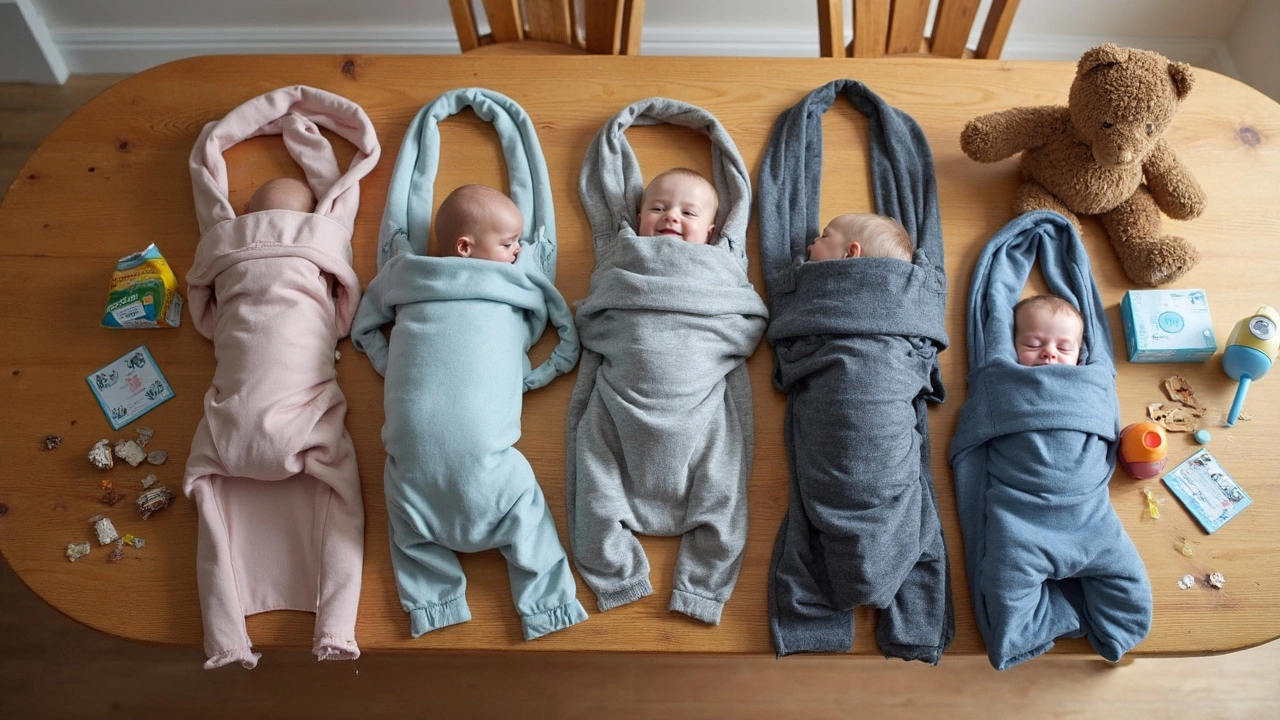How Often Do You Wash a Baby Carrier? Practical Tips for Everyday Parents

Baby carriers make life so much easier, but they take a serious beating—think drool, snack crumbs, and the occasional diaper blowout. So, how often are you supposed to wash these things? The answer isn’t one-size-fits-all. It depends a lot on your baby’s age, your carrier's material, and, honestly, how messy daily life gets.
Baby carriers get way closer to your baby’s skin (and mouth) than most of their clothes, so keeping them clean is about more than just looking nice. Dirty carriers can collect germs, dust, and allergens that may cause skin irritation or even make your child sick. But washing too much can wear out the fabric and mess with safety features like buckles or straps.
The trick is finding a routine that keeps things hygienic but doesn’t send you into endless laundry mode. Wondering if you can just wipe up a spot or if it’s time for a full wash cycle? You’ll want to look for certain signs—like sticky patches, odors, and built-up stains. And don’t forget, how you clean matters as much as when you clean! Always check that care tag for dos and don’ts; some carriers need baby-gentle soap or have parts that don’t go in the machine.
- Why Washing Matters: Germs, Spit-Up, and Snacks
- Reading the Fine Print: Care Labels Decoded
- How Often Is Enough? Real-Life Cleaning Schedules
- Spot Cleaning vs. Full Wash: What’s the Difference?
- Making Your Carrier Last: Pro Tips for Busy Parents
Why Washing Matters: Germs, Spit-Up, and Snacks
Let’s get real—your baby carrier goes everywhere. It catches spit-up, wipes noses, and is basically a mobile snack zone. All that action means it’s also a magnet for bacteria and dirt, so skipping washes just isn’t an option. According to a study by NSF International, fabric baby gear like carriers and car seats can be among the dirtiest baby items, holding more germs than the average toilet seat. Yikes.
It's not just about the gross factor, either. Babies love to gnaw on the straps and suck on the panels, especially during teething. That turns the carrier into a front-row seat for germs to get right into their mouths. And since newborn immune systems are still developing, they’re way more likely to react to stuff like dust mites, pet hair, and random food bits hiding in the fabric. Keeping your baby carrier clean actually helps prevent breakouts, sniffles, and tummy troubles.
Mess is just a fact of life with little ones around. Here’s a quick breakdown of the main offenders:
- Germs and Bacteria: Sweat and saliva soak into the fabric, letting germs hang around for days. Some bacteria can even lead to rashes or bad smells if left unchecked.
- Spit-Up: Especially common with babies under six months. These stains set fast and can make the carrier stiff or sticky if not cleaned soon.
- Snacks and Crumbs: Everything from cereal bits to banana mush ends up stuck in seams. Food attracts even more bacteria and can get gross quickly.
You might be surprised how fast things add up. One quick snack session can leave enough crumbs to fill your palm.
| Common Mess | How Quickly It Builds Up |
|---|---|
| Crumbs & Food | Every use |
| Spit-Up | 1-2 times/week (for babies under 6 months) |
| Visible Dirt | 1-2 weeks (depending on use) |
So, if you’re asking yourself why you should bother cleaning that baby carrier so often, remember—it’s about your baby's health and comfort. Smells and stains are only the beginning. The best move is to wash before grossness sets in, not just after the latest disaster.
Reading the Fine Print: Care Labels Decoded
Care labels might look like a jumble of symbols, but they hold the secret to keeping your baby carrier in one piece. Every carrier has its quirks—some need special handling, others can just be tossed in the wash. Those little tags tucked inside the fabric let you know exactly what’s safe to do and what’s not.
Most baby carrier cleaning instructions will say if the whole thing can take a spin in your machine, or if it’s hand-wash only. Pay close attention to warnings about hot water or tumble drying. High heat can ruin things like buckles, foam, or even shrink the fabric, which you definitely don’t want. You’ll often see recommendations for mild detergent—steer clear of bleach, fabric softener, and anything too harsh, since these can mess up the fabric’s color and strength.
- Machine washable: Some soft-structured carriers are built for convenience. Throw them in on a gentle, cold cycle but avoid the dryer unless the label specifically says it’s okay.
- Hand-wash only: These need gentler care—usually you’ll need cool water and a little baby-safe soap in the sink or tub.
- Spot clean: If your carrier has a lot of padding, rings, or wood attachments, spot cleaning is often the only safe option. Use a damp cloth and mild soap.
Here’s something not everyone knows: some carriers have removable infant inserts or covers that come with separate care instructions. Washing them together with the carrier can ruin the fit or mess with padding. Always check tags on both the carrier itself and any add-ons you use.
| Symbol | What It Means |
|---|---|
| 🧺 | Machine washable (watch the temperature) |
| 🤲 | Hand wash (handle gently, don’t wring out) |
| 🚫☀️ | No direct sunlight for drying (could fade fabric) |
| 🚫🔥 | No tumble drying (air-dry is safest) |
| 🧼 | Mild or baby-safe detergent only |
When in doubt, check the brand’s website—they usually have up-to-date washing frequency and cleaning advice for your exact model. Following label rules keeps the straps, buckles, and fabric in shape, which matters for comfort and safety every time you and your baby head out.

How Often Is Enough? Real-Life Cleaning Schedules
If you’re staring at your baby carrier cleaning to-do list and feeling lost, you’re not alone. Every parent’s reality is a bit different, but there are some solid guidelines that help keep things simple—and safe for your little one.
As a rule of thumb, most soft-structured carriers and wraps only need a full wash every 2-4 weeks, unless they’ve been hit with a diaper emergency, major spit-up, or a full-on snack explosion. For everyday messes, spot cleaning does the trick unless you notice stains or funky odors. Slings and mei tais can usually go a little longer between washes because they tend to soak up less drool and crumbs.
Here’s a quick run-down to keep your washing frequency realistic:
- Everyday grime: Spot clean as soon as you see any visible dirt, wet patch, or food.
- Major messes: Immediate full wash. No point waiting if bodily fluids are involved.
- General use: Full wash every 2-4 weeks if using daily. If it only sees action on weekends, you can stretch it to once a month.
- Travel or sick days: Wash immediately after big outings or if your baby has been under the weather, to cut down on germs and allergens.
A recent survey by a large babywearing community found over 60% of parents washed their carriers every two to four weeks, while about 25% admitted to going a few months—usually just spot cleaning unless disaster struck. So, you’re not failing if it’s been a few weeks since the last wash!
| Carrier Type | Average Washing Frequency |
|---|---|
| Soft-structured (everyday use) | Every 2-3 weeks |
| Wraps/Slings (light use) | Every 4 weeks |
| Mei Tai | Every 3-4 weeks |
| After illness/outdoors | Immediately |
Keep in mind, overwashing can wear down the fibers and stress the seams. If your baby carrier care tag says hand wash only, it’s not just being picky—following those rules can give your gear a much longer life.
Spot Cleaning vs. Full Wash: What’s the Difference?
Not every mess means you need a spin cycle. With baby carrier cleaning, spot cleaning and doing a full wash do totally different jobs, and knowing when to do which will save you time and help your gear last.
Spot cleaning is simple—think of it as damage control. If your kiddo drools on the strap or you notice a tiny food smudge, break out a gentle cloth, a little warm water, and maybe a drop of baby-safe soap. Quickly rub the mess, and let it air dry. You don’t need to soak the whole thing. This method is perfect for everyday oopsies and keeps stains from setting in before laundry day. Plus, it’s recommended by most brands, including Ergobaby and BabyBjörn, for minor messes.
- Baby carrier care tip: Don’t use harsh bleach or strong chemicals—these break down fibers and can irritate sensitive baby skin.
- Focus on sweat, spit-up, or sticky spots. If it isn’t spreading, no need for a full wash yet.
On the other hand, a full wash means throwing the entire carrier in the washing machine (or hand-washing, if required by your label). This isn’t something you’ll do every week—unless you’re in constant blowout territory. Go for a full wash when:
- Your carrier smells, even after air-outs.
- You notice built-up grime around buckles or seams.
- Your baby’s been sick (think cold, stomach bug, etc.).
If you’re machine-washing, use a gentle cycle and put buckles in a pillowcase or mesh bag so they don’t get banged up. Always use mild detergent—no fabric softeners or bleach. And let your carrier air dry—tossing it in the dryer can warp the structure or shrink padding.
Wondering how parents actually split it up? Here’s what a quick survey from a popular parenting forum found:
| Cleaning Method | How Often by Most Parents |
|---|---|
| Spot Cleaning | 2-3 times a week |
| Full Wash | Once every 2-4 weeks (or sooner if there's a big mess) |
Being smart about washing frequency and how you clean means your carrier stays fresh without wearing out early. Sometimes, that quick wipe is all you need—save the big wash for the real disasters.

Making Your Carrier Last: Pro Tips for Busy Parents
Keeping your baby carrier in solid shape is easier than you think, but it does take a bit of care. A lot of damage comes from doing things the wrong way—like using harsh detergent, tossing everything in the dryer on high, or skipping those care instructions altogether. Saving your gear (and money) just means sticking to a few tried-and-true habits.
- Skip the harsh stuff: Go for mild, baby-safe detergents. Regular detergents can cause fabric colors to fade and may even irritate your little one’s skin.
- Cool and gentle wins: Stick with cold water and the gentle cycle if you’re using the machine. Hot water wears out elastics and buckles way faster.
- Watch the dryer: High heat is a carrier’s enemy. Air-dry whenever you can. If you must use the dryer, pick the lowest heat setting and pull it out as soon as it’s not sopping wet.
- Store smart: Don’t just toss your carrier into the stroller basket or diaper bag. When you’re not using it, hang it up or roll it gently, so straps and buckles don’t get bent out of shape.
- Spot clean early: Sticky messes are way easier to wipe up right away with a damp cloth than after they’ve set. Try a quick spot clean before washing the whole thing.
The stats tell the story: a 2024 survey by carrier brand Ergobaby showed that carriers washed according to the care label lasted 30% longer than those that weren’t. Reading those tiny tags? Honestly saves a lot of headaches. And if your baby carrier has removable inserts or padding, take them out before washing to prevent lumpy foam or tangled straps.
One more thing: inspect it often. Check for weak seams and any stretching near the buckles. Catching those little problems early can save your carrier from a total breakdown right when you need it for a grocery store meltdown.
| Care Hack | Result |
|---|---|
| Wash on gentle, cold cycle | Preserves fabric and colors |
| Air-dry flat | Keeps shape, protects elastic |
| Spot clean new stains | Prevents permanent marks |
Remember, when it comes to baby carrier care, a little effort up front means less trouble (and spending) down the road.


